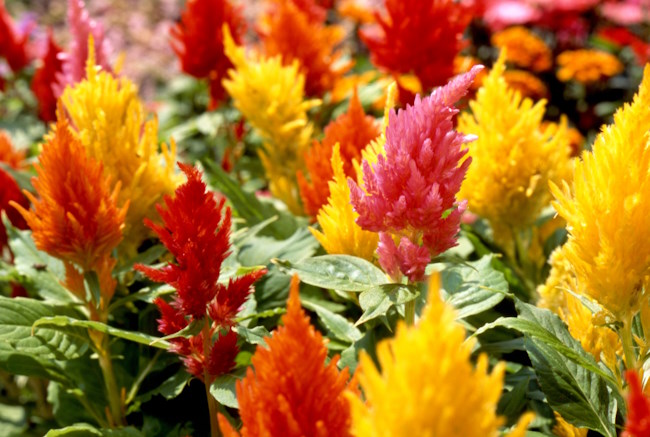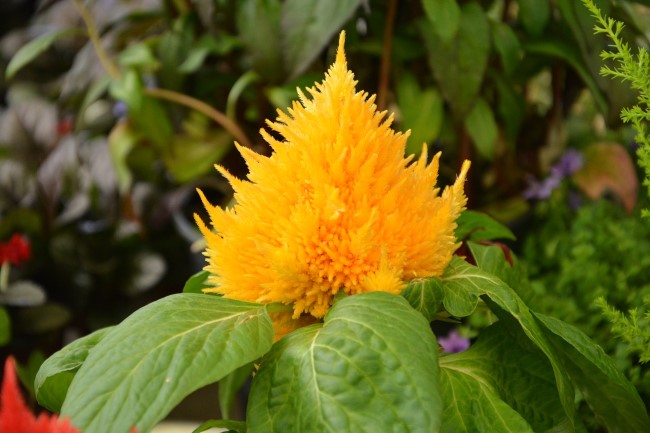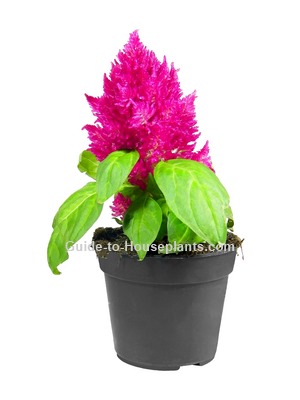Celosia Plumosa Care
Botanical Name: Celosia argentea var. plumosa
Celosia plumosa is finally getting some of the recognition it deserves. Plant a variety of colors together for a scene-stealing performance. You'll enjoy those big, bright blooms that last from spring through fall.
 These brightly colored beauties show off best in mass plantings. Photo ©Yusaku Takeda | Dreamstime.com
These brightly colored beauties show off best in mass plantings. Photo ©Yusaku Takeda | Dreamstime.comCelosia Varieties
You have lots of colors to choose from -- vivid shades of red, yellow, orange and pink are the most common. Many celosia varieties are available, including dwarf hybrids. You'll often find them for sale as Celosia Plumosa.
'Fresh Look' red celosia is a popular cultivar with big, feathery plumes. 'Fresh Look' is also available in yellow and gold.
Celosia flowers are in the Amaranthaceae family and are basically of two groups. The variety shown here is the plumosa group. It's the more popular of the two, often grown in flower beds, containers, and indoors as house plants. The second group is cristata, also known as cockscomb for its wavy crest of flowerheads.
 Bright flowers make Celosia plumosa a joy to grow indoors or out. Image: JacLou DL
Bright flowers make Celosia plumosa a joy to grow indoors or out. Image: JacLou DLGet to Know Celosia Plumosa
Soft, deeply veined leaves cover the fleshy stems that hold the feathery blooms upright, above the foliage. The vibrant plumes of colors are eye-catching and look spectacular when grouped together in containers.
It is low-maintenance and easy to grow from seed. Some seeds are sold as "mixed" so you can enjoy a variety. Started plants are also easy to find in garden centers in spring and summer.
Find a spot for celosia in a sunny window or scoot the container outdoors for show-stopping color on your porch or patio. These striking celosia flowers thrive in hot, sunny conditions.
Is Celosia poisonous to pets? No, celosia plants are not toxic to cats, dogs or people, according to the ASPCA. You can grow them without worry.
How big does Celosia argentea var. plumosa get? It'll reach a height of 6 inches to 2 ft (15-60 cm), depending on the cultivar and growing conditions. Dwarf varieties are available, growing 6 to 8 inches (15 - 20 cm) in height.
Does Celosia plumosa come back every year? This compact plant is a tender perennial, typically grown as an annual in cold-winter regions. It's not likely to bloom again, so you can toss it out when it's finished blooming.
Or...off with their heads!
Those brilliant flower heads are long-lasting when cut, and will make beautiful dried flowers.
To dry them, cut off the flower heads, with some of the stem attached, at the end of the season. Hang them in bunches, upside down, in a dry place.

Celosia Plumosa Plant Care Tips
Origin: Hybrids with parents from Tropical Asia
Light: Full sun. You can grow this sun-lover on a windowsill or in a sunroom. Don't have a sunny spot indoors? Moving your celosia plant outdoors for the spring and summer will give it the sunlight it needs to bloom.
Water: Water regularly and thoroughly to maintain evenly moist potting medium. It doesn't like to dry out, but it doesn't like soggy soil either. Use a pot with a drainage hole to prevent root rot.
Humidity: Average room (around 40% relative humidity). Higher humidity levels suit this tropical native, if you choose to move it outdoors for the warm months.
Temperature: Warm room temperatures 70-80°F/21-27°C. If you move your plant outdoors for the summer, don't worry -- it can take the heat. But it's frost tender. In fact, it doesn't do well in cool temperatures, so be sure to bring it back indoors when the temperature drops in fall.
Soil: Peat moss-based potting mix
Fertilizer: Feed monthly with a high-phosphorous water-soluble fertilizer, diluted by half.
Propagation: Easy to grow from seeds. Sow celosia seeds indoors 6 to 8 weeks before the last frost. Seeds need to be above 70°F/21°C to germinate; use a seedling heat mat for best results. You can expect seeds to germinate in about 10 days. Waiting for these beauties to bloom takes more patience -- expect to wait another 8 to 10 weeks for the flowers.


